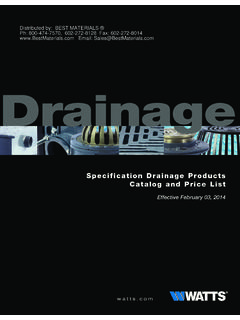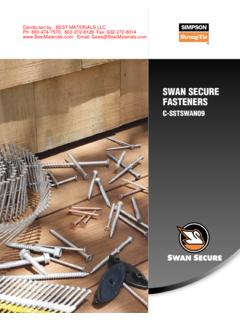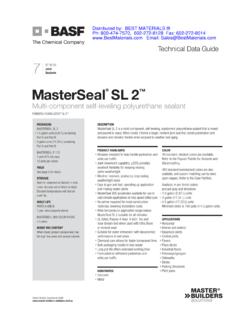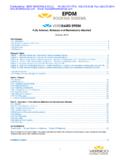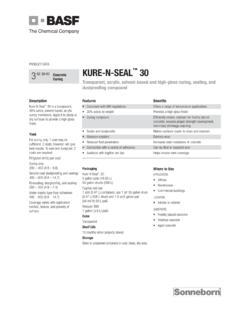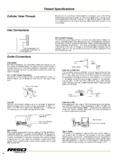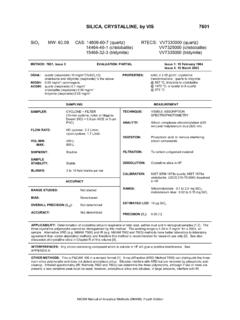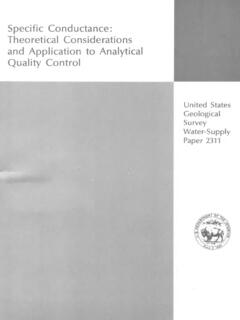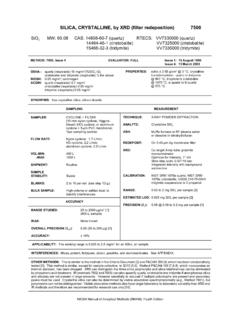Transcription of Guide to Concrete Repair - Best Materials
1 Preface This Guide contains the expertise ofnumerous individuals who havedirectly assisted the author on manyconcrete Repair projects or freelyshared their Concrete repairknowledge whenever requested. Their substantial contributions to thepreparation of this Guide areacknowledged and appreciated. Someof the material in this Guide originatedin the various editions ofReclamation s Concrete Manual. Theauthor edited, revised, or updated thisinformation for inclusion who have been especiallyhelpful to the author include James , former Reclamationengineer, mentor, and friend,deceased; Edward M. Harboe, Reclamation engineer, retired; Cash, Reclamation technician,deceased; Dennis O. Arney,Reclamation technician, retired; DePuy, Reclamation engineer,former supervisor and friend, retired; andKurt D.
2 Mitchell, Reclamationtechnician. Dr. Dave Harris,Manager, Materials Engineering andResearch Laboratory, obtained muchof the funding to prepare this Guide ;Kurt F. Von Fay, Civil Engineer, Materials Engineering and ResearchLaboratories, performed the peerreview; James E. McDonald,Structures Laboratory, WaterwaysExperiment Station, Army Corpsof Engineers, provided editorialreviews of selected information andmany useful sug-gestions andparticipated with the author in severalcooperative Reclamation Corpsof Engineers Concrete Repair programs. The assistance of these and numerousother engineers and technicians isgratefully PageChapter I Repair of Concrete .. of Requirements for Quality 3 Chapter II A Concrete Repair the Cause(s) of the Extent of the Need to the Repair the Old Concrete for the Repair the Repair 18 Chapter III Causes of Damage to Concrete Mix Caused by Cyclic Freezing and of Reinforcing 43 Chapter IV Standard Methods of Concrete Cement Pack and Epoxy-Bonded Dry Aggregate Epoxy Replacement Polymer Concrete Molecular Weight Methacrylic Sealing Surface Fume Siloxane Sealing 96iiPageChapter V Nonstandard Methods of of Nonstandard Repair 101 Appendix AFiguresFigurePage1 Lack of maintenance has resulted in near loss of this irrigation 22 Deferred maintenance has allowed freezing and thawing deterioration to seriously damage this 23
3 Freezing and thawing deterioration to the downstream face of this dam does not require Repair for safe operation of the 94 This freezing and thawing deterioration should have been repaired before it advanced to the point that wall replacement or removal is the only 95 Absorptive aggregate popout on a spillway 106 Spillway damage requiring repairs at some future 107 This Concrete damage was found to be a serious threat to the structural integrity of this 118 Saw cut patterns for the perimeters of Repair 129 Corners of Repair areas should be rounded whenever 1310 Shot blasting equipment used to remove shallow Concrete 1411 Scrabbler equipment used to remove shallow Concrete 1512 Multiple bits on the head of a scrabbler pound and pulverize the Concrete surface during the removal 1613 Correct preparation of a Concrete delamination.
4 Perimeter has been sawcut to a minimum depth of 1 inch, and Concrete has been removed to at least 1 inch beneath exposed reinforcing 1614 Preparation of a Concrete deterioration that extends completely through a Concrete 1715 Preparation of a shallow defect on a highway bridge 1716 Relation between durability and water-cement ratio for air entrained and nonair- entrained 2017 Delamination caused by solar 2218 Gel resulting from alkali-aggregate reaction causes expansion and tension cracks in a Concrete 2419 Severe cracking caused by alkali-aggregate 2520 Freezing and thawing deterioration on small irrigation gate 2721 Freezing and thawing deterioration on spillway 2722D-cracking type of freezing and thawing 2823 Abrasion-erosion damage in a Concrete stilling 2924 Abrasion-erosion damage caused by
5 Sand or 2925 Early stages of abrasion-erosion 3026 Placing silica fume Concrete to Repair a spillway floor damaged by cyclic freezing and thawing and 3127 Typical Christmas tree pattern of progressive cavitation 3228 Extensive cavitation damage to Glen Canyon 33iiiFigurePage29 Concrete damage caused by chloride-induced corrosion of reinforcing steel. The waters contained within this flume had high chloride 3530 Concrete deterioration caused by acidic 3631 The depth of acidic water on this Concrete wall is very 3632 Typical appearance of drying shrinkage 3833 Plastic shrinkage cracking caused by high evaporative water loss while the Concrete was still in a plastic 3934 Inadequate crack Repair techniques often result in poor appearance upon 4035 Improper crack Repair techniques often result in short service 4036 Crack gage installed across a crack will allow determination of progressive widening or movement of the crack.
6 It may be necessary to monitor such gages for periods up to a year to predict future crack 4137A large reflective crack has formed in a Concrete overlay which also exhibits circular drying shrinkage 4238 Multiple causes of damage are apparent in this photograph. Poor design or construction practices placed the electrical conduit too near the surface. A combination of freezing and thawing deterioration and alkali-aggregate reaction is responsible for the cracking and surface spalling on the parapet 4439A portland cement mortar patch seldom matches the color of the original Concrete unless special efforts are taken to blend white cement with normal portland 4740A small size pneumatic gun can be used to apply portland cement mortar. Regular shotcreting equipment would be too large for this 4741 Saw-tooth bit used to cut slot for dry 4942 The downstream face of Barker Dam, near Boulder, Colorado, was resurfaced with prepacked aggregate 5143 Dry mix shotcrete equipment being used in the Denver Concrete 5444 Dry mix shotcrete equipment showing the nozzle and water injection 5445 Wet mix shotcrete equipment.
7 The premixed shotcrete is delivered to the shotcrete pump by a transit 5546 Wet mix shotcrete is propelled by compressed 5547 Preparation of a wall for placement of replacement Concrete 5948 Detail of forms for Concrete replacement in 6049A gas-fired forced air heater is being used to heat Concrete prior to application of epoxy 6450An enclosure has been constructed over an area to be repaired with epoxy mortar to keep the Concrete 6651A bucket mixer can be used to mix epoxy mortar for small Repair 6652 Epoxy mortar is consolidated and compacted by hand 6853 Applying the steel trowel finish required by epoxy mortar 6854 Postcuring heating enclosure installed over an epoxy mortar Repair 6955If forms are required for epoxy-bonded Concrete repairs, they should be installed at least once prior to application of the epoxy bond coat to ensure that they fit as planned and that they can be installed and filled before the bond coat 7156 The placement techniques for epoxy-bonded Concrete are essentially the same as for conventional 7257 Placing polymer Concrete in a Repair area.
8 Sandbags and polyethylene sheeting were used to prevent water from entering the Repair 7558 Small stinger vibrators can be used to consolidate shallow depths of polymer 76ivFigurePage59 Polymer Concrete must be protected from water and not disturbed during the 1- to 2-hour curing period. No other curing procedures are required unless ambient temperatures are very 7660 The thin PC overlay system may be applied with push brooms, squeegees, or heavy industrial grade paint 7961 The thin PC overlay system can be applied very quickly. Two workmen completed application to this powerplant roof in 2 8062 Proprietary epoxy injection equipment. Such equipment does not mix with resin components until the point of 8363 Commercial polyurethane injection 8464 This is an air-powered pump system used for large scale polyurethane resin 8565An injection port with zirc fitting and a valved wall spear are shown in this photograph.
9 The wall spear can be used to relieve water pressure and to inject 8766 Several different types of injection port are shown in this 8867A proprietary downhole packer allows separation of the resin components until they reach the downhole point of 8968 High molecular weight methacrylic sealing compound is being applied to the crest of Kortes Dam, near Casper, 9069 This workman is hand screeding a small silica fume Concrete 9570 Using a bull float on a silica fume Concrete Repair . Finishing must be done immediately after 9571 Curing compound and polyethylene sheeting should be applied to cure silica fume Concrete as soon as finishing is completed if drying shrinkage cracking is to be 9672A paint roller application of siloxane sealing compound to the downstream face of Nambe Falls Dam, near Sante Fe, New 971 Chapter I Repair of Concrete1.
10 Introduction. For many years, the Bureauof Reclamation (Reclamation) has published theConcrete Manual, the first edition dated July1938, and more recently, the StandardSpecifications For Repair of Concrete , M-47,the first edition dated November 1970. Thesubsequent revisions of these two documents(Bureau of Reclamation, 1975 and 1996),particularly chapter 7 of the Concrete Manual,have formed the basis for nearly all concreterepair performed on Reclamation projectsduring the past 25 years. Reclamation operates and maintains a waterresources infrastructure, located primarily in theharsh climatic zones of the Western UnitedStates, valued at over $17 billion. It hasbecome apparent that there is need formodernization and expansion of the informationon the methods, Materials , and procedures ofconcrete Repair originally found in chapter 7 ofthe Concrete Manual.

